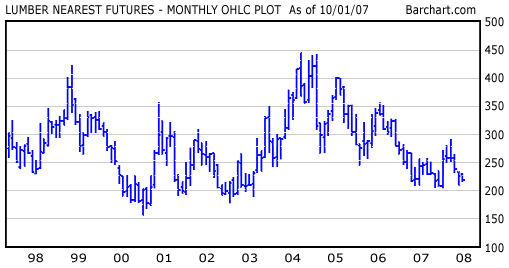By Tom Dyson | 8 October 2007
Don Magruder is general manager of a large lumber and supply warehouse in Florida. He's worked in the lumber business for 25 years. I spoke to Don on the telephone last week...
"The commodity wood markets are just about in total collapse," says Don. "There is no other way to spin it."
Last month, lumber and plywood prices fell 13%. Oriented strand board sheetings prices are at the lowest levels Don has seen in 10 years. OSB sheetings are the large wooden sheets Floridians use to cover up their windows before hurricanes. They are made from hundreds of woodchips glued together.
"Prices... have dropped too much," says Don. "When markets drop to dramatic low levels without any major [improvement] in technology or productivity, that sends a message that people are getting desperate."
Here's a 10-year chart of the Chicago Mercantile Exchange's lumber futures contract. Prices are near their lowest levels of the last 15 years.

Houses in America are built of wood. Right now, demand for houses is at a 12-year low, and the construction industry's demand for lumber has fallen off a cliff. This is why lumber prices are falling so fast.
When demand for a commodity plummets, you'd expect a supply glut to develop. Producers ramp up capacity during the bull market. Then demand slackens, but producers never see it coming and keep cranking out the commodity. Prices fall.
Here's the thing: The lumber market right now does not have a supply glut. There's a severe shortage. Don says inventories of lumber and wood products are at their lowest levels in years.
"Businesses have reduced inventories to match sales— which are down 50%," says Don. "Plus many manufacturers have reduced production or even closed facilities."
Canada is another reason. A Canadian pine tree is no different than an American pine tree. But when one U.S. dollar traded at Canadian $1.60 five years ago, it gave a huge advantage to Canadian wood producers. They received the same price for their products, but their costs were 60% lower.
Now the Canadian dollar is at parity with the U.S. dollar. Canadian producers are going out of business. Thus, Canadian wood floods the American market no longer. I wrote about this trend in last Wednesday's edition.
Low prices and tight supply in the same market? This is the perfect set up for a bull market in lumber. What could trigger this bull market?
Don thinks foreign buying will support the U.S. housing market— especially in Florida— given the cheap dollar. I've written about this trend here. This should support lumber prices going forward. But a large hurricane is Don's big concern:
"The economic downturn has created a high risk for major material shortages coupled with dramatically escalating prices," he says, "if a hurricane were to hit a major population area of the United States."
So, how do we profit from this situation?
You could rent a warehouse near a train track and fill it with plywood and OSB sheeting. But that's cumbersome. You could open a futures trading account and buy a lumber contract. But this is not suitable for inexperienced futures traders.
The stock market offers the easiest route: Simply buy American companies that produce lumber, plywood, and OSB sheeting. They are cheap, the foreign exchange market has crippled their Canadian competition, and their products are surely about to jump in price.
Normxxx
______________
The contents of any third-party letters/reports above do not necessarily reflect the opinions or viewpoint of normxxx. They are provided for informational/educational purposes only.
The content of any message or post by normxxx anywhere on this site is not to be construed as constituting market or investment advice. Such is intended for educational purposes only. Individuals should always consult with their own advisors for specific investment advice.

No comments:
Post a Comment